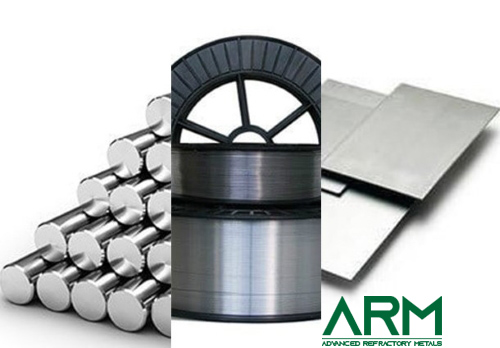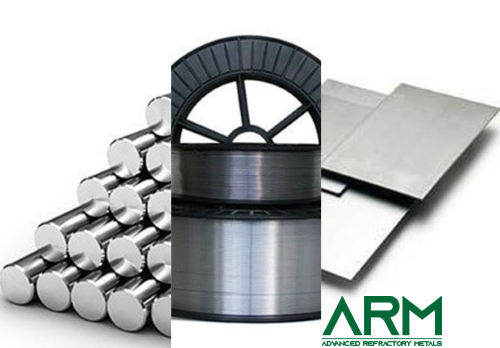Five Refractory Metals: Properties, Alloys, and Applications

What Are Refractory Metals?
Refractory metals form a unique group of materials that stand apart due to their exceptional resistance to heat, corrosion, and wear. Defined by their melting points exceeding 2000°C (3632°F), these metals—molybdenum, tantalum, tungsten, niobium, and rhenium—play critical roles in high-performance industries. Their extraordinary thermal and mechanical properties make them indispensable in demanding applications, such as aerospace, energy, defense, and electronics.

Common Features of Refractory Metals
Refractory metals share several key properties that make them stand out as a unique group of materials for high-performance applications. These include:
- High Melting Points
All refractory metals have melting points exceeding 2000°C (3632°F), with tungsten having the highest melting point of any metal at 3422°C (6192°F). This allows them to remain stable and functional in extreme heat environments.
- Exceptional Strength at High Temperatures
These metals maintain their mechanical strength and resist deformation under stress at elevated temperatures, making them ideal for applications in aerospace, power generation, and industrial furnaces.
- High Density
Refractory metals like tungsten and rhenium are incredibly dense, enabling their use in radiation shielding, counterweights, and high-stress applications.
- Corrosion Resistance
Most refractory metals are chemically stable and resist oxidation and corrosion in aggressive environments. Tantalum, for instance, is highly resistant to acids, making it suitable for chemical processing.
- Hardness and Wear Resistance
Refractory metals are exceptionally hard, making them resistant to wear and abrasion. Tungsten, for example, is widely used in cutting tools and hard coatings.
- Good Thermal and Electrical Conductivity
These metals conduct heat and electricity effectively, which is essential in applications like electronics, heat exchangers, and rocket engine components.
- Versatility in Alloys
Refractory metals readily alloy with other materials to enhance properties such as machinability, strength, and resistance to creep or oxidation. Alloys like TZM (molybdenum-based) and C103 (niobium-based) are examples of tailored solutions for specific applications.
|
Property |
Molybdenum (Mo) |
Tantalum (Ta) |
Tungsten (W) |
Niobium (Nb) |
Rhenium (Re) |
|
Melting Point (°C) |
2623 |
3017 |
3422 |
2477 |
3186 |
|
Density (g/cm³) |
10.28 |
16.65 |
19.25 |
8.57 |
21.02 |
|
Hardness (Mohs) |
5.5 |
6.5 |
7.5 |
6 |
7 |
|
Thermal Conductivity (W/m·K) |
138 |
57 |
173 |
54 |
48 |
|
Electrical Resistivity (µΩ·cm) |
5.3 |
12.4 |
5.5 |
15.2 |
19.3 |
|
Coefficient of Thermal Expansion (10⁻⁶/K) |
5.3 |
6.3 |
4.5 |
7.3 |
6.2 |
For more information, please visit Advanced Refractory Metals (ARM).
What Are the Five Refractory Metals?
--Molybdenum: Versatility and Strength
Molybdenum is known for its high thermal conductivity and low thermal expansion, which make it stable under extreme heat and ideal for thermal management. With a melting point of 2623°C (4753°F) and a density of 10.28 g/cm³, molybdenum is widely used in aerospace, energy, and electronics. Its ability to maintain strength at high temperatures enables its use in rocket nozzles, furnace components, and heat exchangers.
The molybdenum alloy TZM (titanium-zirconium-molybdenum) enhances strength and creep resistance, making it a top choice for power generation and aerospace applications. Additionally, molybdenum's excellent electrical conductivity supports its use in semiconductor substrates and thin-film transistors.
--Tantalum: Corrosion Resistance and Biocompatibility
Tantalum stands out for its exceptional corrosion resistance, particularly against acids, which makes it invaluable in chemical processing equipment. It has a melting point of 3017°C (5463°F) and a density of 16.65 g/cm³. Tantalum’s inertness and biocompatibility have also made it a favorite in the medical field, where it is used in implants and surgical instruments.
Tantalum alloys, such as tantalum-tungsten (Ta-W), combine corrosion resistance with added strength, further expanding its usability in harsh chemical environments. Applications range from capacitors and vacuum furnace components to tantalum implants and nuclear reactor parts.
--Tungsten: Density and Durability
Tungsten has the highest melting point of all metals, at 3422°C (6192°F), and an impressive density of 19.25 g/cm³, making it unmatched for high-temperature and high-density applications. Tungsten is extremely hard, making it essential for cutting tools, X-ray shielding, and other demanding uses.
Tungsten alloys like WHA (tungsten heavy alloys) are used for radiation shielding, counterweights, and aerospace components. Another notable alloy, TA10W (a tantalum-tungsten alloy), is designed for extreme heat applications, such as in space propulsion systems. Tungsten’s exceptional thermal and wear resistance ensures its use in filaments, furnace parts, and defense applications like ballistic missiles.
--Niobium: Lightweight and Resistant
Niobium’s combination of low density (8.57 g/cm³) and high melting point (2477°C or 4491°F) makes it an ideal choice for applications requiring lightweight materials with excellent heat resistance. It is widely used in the aerospace industry, where every gram counts in the quest for performance and efficiency.
One of the most significant niobium alloys is C103, a niobium-based material containing hafnium and titanium. This alloy excels in high-temperature environments and is a staple in rocket engine components and spacecraft nozzles. Niobium also plays a key role in superconducting materials and medical imaging, further showcasing its versatility.
--Rhenium: Rare and Resilient
Rhenium is among the rarest metals on Earth, known for its exceptional strength and stability at high temperatures. With a melting point of 3186°C (5767°F) and a density of 21.02 g/cm³, rhenium is indispensable in the aerospace and energy industries. It is used in turbine engines and space exploration due to its resistance to creep and oxidation under extreme heat.
Rhenium’s catalytic properties make it a critical material in the petroleum refining industry, where it is alloyed with platinum to improve efficiency. In addition, rhenium-molybdenum alloys are used in high-temperature structural applications like rocket nozzles and thermocouples. Despite its cost, rhenium’s unique properties ensure its place in critical technologies.
Conclusion
Refractory metals—molybdenum, tantalum, tungsten, niobium, and rhenium—are indispensable in the modern world, enabling technologies that operate at the limits of temperature, pressure, and wear. Their unique properties, coupled with their ability to form versatile alloys, make them essential across a wide range of applications. As new challenges emerge in aerospace, energy, medicine, and beyond, refractory metals will continue to be the foundation of innovation, driving progress in some of the most demanding fields known to humanity.
Further reading:
{{item.content}}
LEVE A REPLY
{{item.children[0].content}}
{{item.content}}






